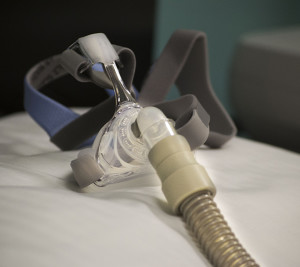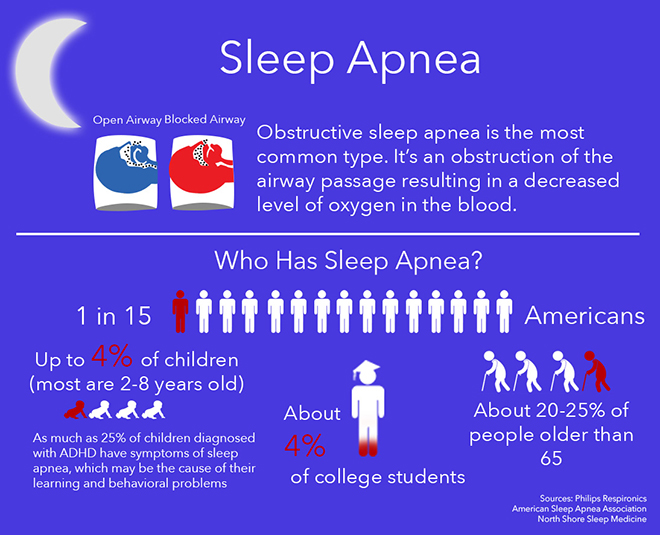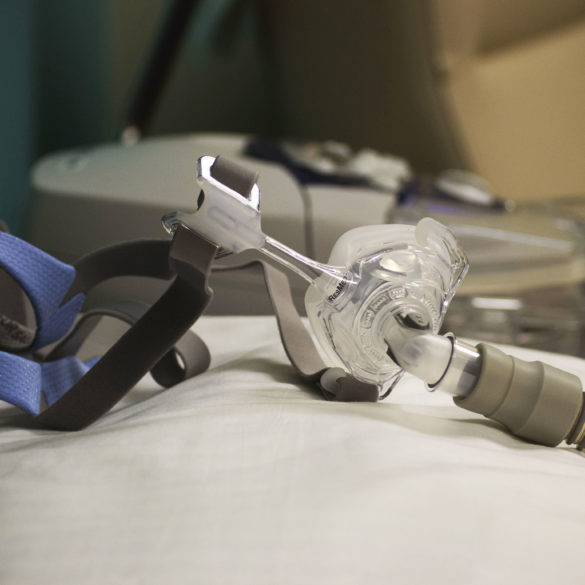College students are all too familiar with long nights and the rare instance of a good night’s sleep. Many may find they are getting less and less sleep, typically due to an overload of activities.
 For a college student that has sleep apnea, getting enough sleep becomes increasingly difficult.
For a college student that has sleep apnea, getting enough sleep becomes increasingly difficult.
Sleep apnea is defined as a “potentially serious sleep disorder in which breathing repeatedly stops and starts.” People with sleep apnea will stop breathing periodically throughout the night and sometimes aren’t even aware that it’s happening.
Dr. Jeff Van Valer, who is board certified in neurology and sleep medicine with the American Health Network, said people can go extended periods of time without breathing while they are asleep.
“I’ve seen someone stop breathing for 90 seconds during a study,” Van Valer said.
He also said that some people with severe sleep apnea may stop breathing 40 times in one hour, and each time, the person may stop breathing for a whole minute. That means they would only be breathing 20 minutes for every hour.
Van Valer said that people may also be completely unaware of these symptoms when they wake up the next morning. This was the case for Ball State freshman Emma Garcia, who suffers from sleep apnea.
“I was just always really tired during the daytime,” Garcia said. “I never really felt like I slept well. I would sleep for long periods of time and just still be really tired.”
Doctors originally did blood work on Garcia to test for iron deficiencies. It was only after her doctors did sleep tests where they discovered she had sleep apnea.
Van Valer said most cases of sleep apnea in college students go undetected.
“I can definitely say it’s more common [in college students] than anybody knows,” he said.
College students can often blame their drowsiness on many different reasons, such as numerous extracurricular activities or long nights of studying. This can cause them to go undiagnosed.
Although people with sleep apnea may not remember their symptoms, there are other symptoms that help someone determine if their drowsiness is caused by sleep apnea.
Snoring is often associated with sleep apnea. When someone snores, their airway is partially closed and it makes it harder to breath. Garcia said that this is sometimes one of her symptoms and she often sleeps on her side to avoid it.
 A person with sleep apnea may also suffer from insomnia because of the difficulty it takes to stay asleep. This makes it even more difficult for a person with sleep apnea to get enough rest. Someone with this medical condition could also have headaches, dry throat and even high-blood pressure while sleeping.
A person with sleep apnea may also suffer from insomnia because of the difficulty it takes to stay asleep. This makes it even more difficult for a person with sleep apnea to get enough rest. Someone with this medical condition could also have headaches, dry throat and even high-blood pressure while sleeping.
Van Valer said that because more is known today about sleep disorders than ever before, it is crucial that people who have sleep apnea are diagnosed.
“When somebody’s sleeping and they’re trying to breathe against a closed airway, they’re basically suffocating,” he said.
College students today on average are getting two less hours of sleep than college students in the 1980s. A student who is getting minimal hours of sleep and also suffering from sleep apnea is putting herself or himself at risk for many other health problems associated with drowsiness, such as poor work performance, mood swings and impaired memory.
Garcia said that although she has not had any traumatic experiences with her condition, she is very aware of how much more it affects her in college.
“I study a lot more and I don’t sleep a lot of hours in the day. If I sleep four hours in the day, I get two actually good hours of sleep because of sleep apnea,” Garcia said.
She deals with these symptoms along with others, and learns to combat them every day.
“I am always tired during the day and because I don’t sleep well I’ve also developed insomnia,” she said. “It’s really hard for me to fall asleep or stay asleep. I have headaches and sometimes I snore.”
Van Valer said that in rare, severe cases, sleep apnea can become fatal, so it is very important for people that suffer from sleep apnea to be aware of it. There are ways to reduce and minimize symptoms when diagnosed early.
“If a college student or any kind of young patient has obstructive apnea, I would absolutely want them to be examined by an ear, nose and throat surgeon,” Van Valer said.
If the condition is caused by a naturally small airway or some other factor, there are different treatments available. A Continuous Positive Airway Pressure (CPAP) is the ideal treatment for patients with sleep apnea. It pressurizes room air and makes sure the patient’s airway stays open so they are able to breath. There are also oral appliances available that pull the patient’s bottom jaw forward in order to open up the airway.
Van Valer also said that alcohol consumption and any kind of sedative medication could worsen sleep apnea. It’s important for patients to know what is causing their sleep apnea so they can minimize the symptoms. If college students that have sleep apnea are diagnosed, they can reduce their symptoms, get better rest, and perform better day to day.
Even though sleep apnea can be dangerous, Van Valer said it is possible to overcome it.
“A lot of people might think that it’s a disease that has no cure,” he said. “I would hate for them to think that because there’s definitely treatment for it.”




